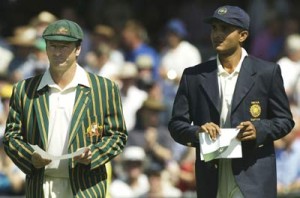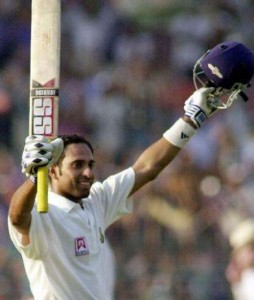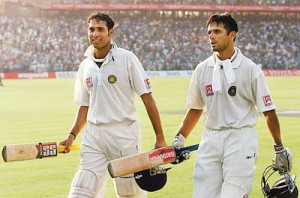
A gradual but inevitable descent into cricket-based loathing and bile.
Classic Series Review: India vs. Australia 2001
By Arjun Miglani
With India on the end of a 4-0 trouncing in Australia, one of our Indian contingent looks back to happier times.
The Final Frontier
There, it’s out of the way now. In the lead-up to this now famous series, that phrase was repeated with cringeworthy regularity by fans, players and pundits alike. Could Australia really claim to be the best team in the world without winning a series in India?
A look at the two sides suggested that the hosts were ripe for the taking. Sure, they still had that middle order (although VVS Laxman still had some people to convince…much more on this later), but there were glaring weaknesses elsewhere. The openers, SS Das and Sadogappan Ramesh (now a Tamil actor, apparently) were new to international cricket and had an air of timidity about them, and the spin department, so long India’s great strength at home, was being spearheaded by the unpredictable Harbhajan Singh, trying to resurrect his career after a turbulent start punctuated with disciplinary breaches (no, really) and allegations of chucking.
Australia, meanwhile, were at their peak. Just looking at their eleven for the first Test, albeit retrospectively, makes one feel inadequate: Slater, Hayden, Langer, The Waughs, Ponting, Gilchrist, Warne, Gillespie, Fleming, McGrath.
The First Test
Australia won the toss at the Wankhede and chose to field.
Ramesh, Dravid and Das all fell early, and when captain Saurav Ganguly also went cheaply to leave the score at 55/4, it looked like being a long series for the hosts. As ever during this era, Sachin Tendulkar looked to be playing on another pitch, making his way to a swashbuckling 76, but when he and Laxman fell in quick succession, it was only a matter of time. India folded for 176 (Ajit Agarkar made yet another duck against the Aussies), and Shane Warne, who had previously had a terrible time in India- on and off the field- picked up four wickets.
India needed early wickets, and there was promise when Agarkar bowled Slater for 10, but Hayden, another one who had struggled on the subcontinent, and Langer took the score to 71.
This is where the Harbhajan Singh story begins. He got rid of Langer, and then Mark Waugh for a duck. Rahul Sanghvi (who? A left-arm spinner who only played this Test, that’s who) ended Steve Waugh’s brief resistance, before Harbhajan started his long spell of dominance over Ponting, removing him for a duck as well. All these wickets were caught by fielders around the bat, a recurring theme throughout the series. The score was 99/5, and Indians everywhere, including yours truly, were delirious. Those silly Aussies and their inability to play spin!
Then Hayden and Gilchrist happened. Hayden swept like a man possessed, getting that lumbering front foot of his as far down the pitch as was humanly possible and swatting everything with disdain. Gilchrist? Well he just did his usual thing. They put on 197 runs in 32 overs. In a Test match! Counter-attacking was what this Australian team was famous for, and this was the perfect example. It was such a devastating blow that India were never in the game from that point on. Hayden made 119, Gilchrist 122, and Australia were eventually dismissed for 349, a whopping lead of 173 runs to their name.
Some things never change, and in the second innings, Tendulkar top-scored again with 65, and Ajit Agarkar made another duck, his seventh in a row against our antipodean friends. India were rolled for 219, leaving Australia 47 to get, which they did, without losing a wicket.
Final frontier? Too easy.
THAT Second Test
Australia made only one change, bringing Michael Kasprowicz in for Damien Fleming, but India threw their bowling attack in the bin, ditching Agarkar, Sanghvi and Javagal Srinath for Venkatesh Prasad, a young Zaheer Khan, and good ol’ Venkatapathy Raju.
The visitors won the toss again and chose to bat. The openers put on 103, before Hayden and Langer added another 90; Hayden falling to Harbhajan on 97 to leave the score at 193/2, and Indian hopes wilting. The partnerships kept building until Harbhajan broke the Waugh brothers’ stand, removing Mark with the score on 236.
In walked Ricky Ponting, but not for long, as he was trapped LBW for six. Watching Ponting play spin on this tour was like watching Ali Dia try to play football. The score was 252, when Gilchrist walked in to join an imperious looking Steve Waugh. We trembled in fear at the thought of the hell he was about to unleash.
Except he was out first ball, LBW to Harbhajan, who was now on a hat-trick. Shane Warne walked out to the middle with the Eden Gardens crowd (a full Eden Gardens is, sadly, increasingly looking like a relic of the past) finding their voice at last. Harbhajan bounded in, Warne tried to glance him towards the leg side, the ball hit something, and Ramesh produced his greatest contribution to the series, taking a great diving catch at short-leg. The umpire’s finger went up and it was a hat-trick.
Upon closer inspection, the Warne dismissal in particular is a bit dubious, although we didn’t have your fancy Hot Spot or Hawkeye in those days (which made Tony Greig’s commentary a lot more bearable). I’ve tweeted Shane to ask if he hit it, but he didn’t reply. So as far as I’m concerned, it came right off the middle.
When Kasprowicz fell, Australia were 269/8. But Steve Waugh, such an expert at batting with the tail, put on a whopping 133 with Jason Gillespie, and a further 43 with McGrath, before eventually becoming Harbhajan’s seventh wicket, perishing at 110. Sure, there had been a hat-trick but Australia had 445, and India did not look like getting to 400 in this series (sound familiar?).
That total looked even more imposing as India’s batting wilted once more. Tendulkar only made 10, and in those days, when Tendulkar went, the innings folded soon after (again, sound familiar?).
A confession: I stopped watching at some point during this innings. I was young, hadn’t really grown to appreciate the intricacies of Test cricket yet, and I didn’t like seeing my team battered. Sue me. So I didn’t watch VVS Laxman’s quickfire 59 live, but it took India from an abysmal 129/9 to a merely pathetic 171 all out. Steve Waugh had no hesitation in enforcing the follow-on.
India started their second innings in slightly better fashion, but lost Ramesh on 52. Everyone was surprised as Laxman strode to the wicket, barely an hour or so after losing his wicket in the first innings. His show of defiance had prompted the Indian management to promote him. Unfortunately, the rest of the pack failed to improve. Tendulkar made another 10, Ganguly made a decent but inadequate 48, and when Dravid walked out at no.6 to join the man he had swapped positions with, India were 232/4, still 42 runs behind.
Then they batted. And they batted and batted and batted. They batted all day on the fourth. I remember going to the movies with friends, something I wouldn’t normally do during a Test match (especially when the movie was “Antz”), and coming out to hear everyone, and I mean everyone, talking about how Laxman and Dravid were doing something special.
That batting, Laxman’s in particular, was orgasmic. Don’t get me wrong, Dravid was immense, but the shots Laxman was playing defied everything about the series so far. He pulled and hooked the fast bowlers with impunity. He danced down the pitch to Warne and smacked him around so viciously that the great spinner resorted to packing the leg side and pitching it in the rough. What did Laxman do? Hit the most sexy inside out cover drives you’ve ever seen, of course.
This innings is why VVS Laxman is still in the Indian side, even though he is clearly past his prime, and has been for about as long as The Rolling Stones. He made 281, Dravid made 180, and they put on THREE HUNDRED AND SEVENTY SIX. When Laxman perished, India were 334 ahead.
At the start of the fifth day, everyone assumed India would bat for half an hour or so at best. They batted till lunch, even batting on a bit after Dravid got out. We had the radio on in school (cricket is more important than a proper education), and students and teachers alike were directing the most creative of profanities at Ganguly for not growing some balls and declaring.
As it was, India had two sessions to get ten wickets.
It took 23 overs for the first, and although Langer also fell before tea, Australia still had eight wickets to last a session.
Immediately after the restart, Mark Waugh’s horrendous tour continued, falling LBW to Raju for a duck. Brother Steve and Hayden were in immense form though, and they put on 50. Then, Waugh was caught at bat-pad off Harbhajan, and India had a minor sniff, with a very nervous Ponting walking to the crease. It took four balls for Harbhajan to get rid of him.
The pitch was, to use the parlance of those times, “a raging turner”, the likes of which we don’t see enough of in India nowadays. So Ganguly threw the ball to Sachin, who bowled quite a bit of his leg/off spinners in those days. He’d only made 20 runs in the match, but within two overs, he had trapped both Hayden and Gilchrist in front. And then he produced what is my favourite moment of the match: the most brilliant googly (remember when that’s what it was called?) to get Warne LBW as well. The look of joy on Sachin’s face, in contrast to Warne’s utter bemusement, is something to behold. Seriously, look it up. Australia were eight down.
Jason Gillespie and Michael Kasprowicz don’t do anything lightly though, and it was starting to look like they might survive until the end, until Harbhajan had Gillespie caught. There was still about an hour left, and McGrath was walking to the crease. Surely only a matter of time.
The pair had batted for 52 excruciating deliveries, before Harbhajan hit McGrath’s pads, and the umpire’s finger went up instantly, sending a nation delirious. McGrath’s reaction to the decision makes his feelings quite evident, but he wasn’t playing a shot, so it’s hard to feel much sympathy for him. It looked out, it was out, and the series was level at 1-1 after one of the greatest Test matches of all time.
The Third Test
The second Test was such a spectacle that people often forget how close this one was.Needless to say, India prepared a spinner’s paradise. Consequently, Australia replaced Kasprowicz with Colin “funky” Miller, he of the blue hair, while India ditched Prasad and poor old Raju, for two new spinners, Sairaj Bahutule and Nilesh Kulkarni. Spinners came out of the taps in India in those days. Oh, and Sameer Dighe replaced the injured Nayan Mongia. Remember that.
Australia won the toss and batted, losing Slater in the first over to Zaheer Khan. The more alert among you might have noticed that India didn’t have a second seamer in their side, but you didn’t account for Saurav Ganguly. He shared the new ball for two courtesy overs, before getting Harbhajan in. He removed Langer with score at 67, and the walking wicket, Mark Waugh, came to the crease.
Except he had found some form, and put on 150 with Hayden. He was replaced by his brother, who added another 123 with the seeminly immortal opener before being dismissed. 340/4.
If you’ve been paying attention, you would have noticed that Ricky Ponting’s entrance to the crease often triggered a collapse in this series. So it proved, with Harbhajan removing him for a duck, and getting the next six wickets. It was a bizarre scorecard. Australia were all out for 391, out of which Hayden had made a brilliant 203 while everyone around him was perishing, before being the last man out. The six batsmen from Ponting down made four runs between them, and three of those were McGrath’s.
Buoyed on by their second innings heroics in the last Test, India finally batted with purpose. The much maligned opening stand put on 123, and the score was 211 when Das fell, bringing Tendulkar to the crease. He’d had a relatively quiet series so far, but he never looked like getting out here. He formed partnerships with all of the “big four”, most notably one of 169 with Dravid. Of particular note was the temerity with which he dismissed Warne to all corners of the Chidambaram stadium. When he finally fell for 126, India were 468/6. They were all out for 501.
With a lead of 110, India had reason to be confident, but not overly so. Any Indian fan has nightmares about chasing any sort of total, so Australia still had a decent chance to put the hosts under pressure.
Ganguly had obviously exerted his arm a bit too much in the first innings, because he only bowled one over this time. The openers put on 82 before Hayden fell, and Australia sprung a surprise by promoting Adam Gilchrist. It failed spectacularly, Harbhajan dismissing him for 1.
There was some resistance from the Waugh brothers, with Mark and Steve making 57 & 47 respectvely, but Harbhajan was a man possessed by now. He took EIGHT wickets in this innings, bringing his tally to 30 for the series. Australia made 264, and India needed 155 to win. For most sides, a formality. Not for India.
S.S. Das was dismissed cheaply by McGrath, but when Ramesh and Laxman took the score to 76, the game seemed over. I, for one, was already celebrating. Then Ramesh got run out, bringing Tendulkar to the crease. The pair took the score to 101, and everything was on course for a series win.
Then Gillespie removed Tendulkar. There were still only 54 runs needed with seven wickets left, but Tendulkar getting out during a chase has this effect on Indians, no matter what the target. It’s our version of Murphy’s Law; the feeling that anything and everything will soon go wrong.
At 117, Ganguly went for four. Five runs later, Dravid was out, dismissed by Colin “F**ing” Miller, of all people. 13 runs later, the blue haired goon went and removed Laxman for 66. Twenty runs remaining, with just the keeper and the bowlers remaining. Bums on seats.
Miller removed Bahutule for a duck. Now, remember I told you to remember Sameer Dighe? Here’s why. He’d hung around for a while without really scoring any, but there were now only three wickets left. Three boundaries (one a streaky edge, but who cares, right?) later there were only four runs left. Game over?
In a final twist, Zaheer Khan, who had hung around with Dighe for half an hour without making a run, was dismissed by McGrath. Four runs left, and Harbhajan, the hero of the series, walked out.
He hit the winning runs. Of course he did. It was the perfect end to one of the greatest series of all time, and certainly the greatest for an Indian.
Harbhajan was, of course, the story of the series. It was an utterly devastating performance, and one he lived off for years to come, until he was finally dropped last year. Spare a thought too for Matthew Hayden, who demolished the bowling while those around him faltered. Other memorable participants include Ponting’s hilarious failures, Ganguly’s hilarious new ball bowling, and Tendulkar’s googly. The second Test is also why Australia don’t enforce follow-ons any more.
And finally, the BCCI would do well to watch the highlights of this series again. There’s nothing quite like Test cricket, and having grown up now (technically at least), I fear I might never witness anything of this sort on Indian shores again.





1 Comment
Post a Comment
1
Matt H
31 Jan 2012 12:53
Very interesting read, particularly as someone who didn’t have the means to watch this at the time.